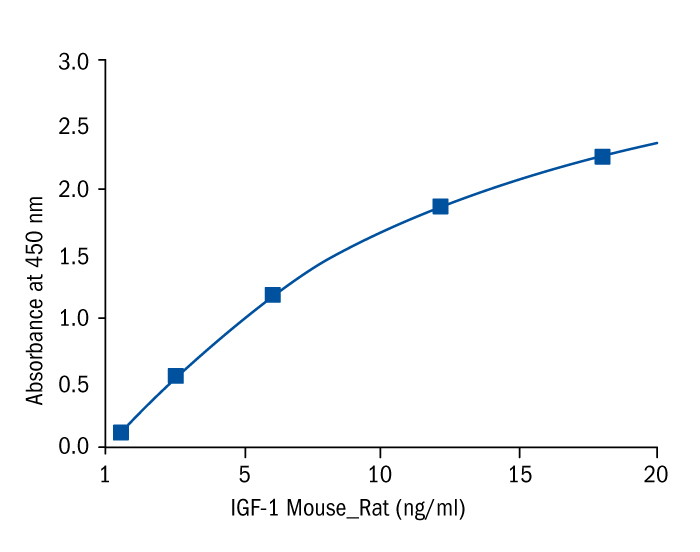Cat # changed from RMEE25R to E25
Type
Sandwich ELISA, Biotin-labelled antibody
Applications
Serum, Plasma
Sample Requirements
10 μl
Shipping
On blue ice packs. Upon receipt, store the product at the temperature recommended below.
Storage/Expiration
Store the complete kit at 2–8°C. Under these conditions, the kit is stable until the expiration date (see label on the box).
Calibration Curve
Calibration Range
0.5–18 ng/ml
Limit of Detection
0.315 ng/mL
Intra-assay (Within-Run)
CV < 10 %
Inter-assay (Run-to-Run)
CV < 10 %
Features
- RUO
- duration: 2h
- Single Standards 0.5 - 18 ng/ml
- 2 Serum Controls, low and high concentrations, lyophilised
- Intra- / Interassay < 10 %
Research topic
Growth hormone and factor-related products, Animal studies
Summary
Beside different cell culture models and studies with human material, mice and rats are suitable model organisms for basic research and pre-clinical studies. Thus, we developed this test system as a tool for IGF-I measurements in mice and rat for usage in research and pre-clinical studies. Even if the comparability of mice and humans is limited, we offer some background information on the human IGF-I system in the following section:
Insulin-like growth factors (IGF) I and II play a pivotal role in regulating the proliferation and differentiation of many cell types (1-3). IGF-I is identical with Somatomedin C (Sm-C) (4) and has a molecular weight of 7649 daltons (5). Its major regulators are growth hormone (GH) and nutrition (6). In contrast to many other peptide hormones, IGFs are avidly bound to specific binding proteins (IGFBP). The seven IGFBPs which are known at present (7,8,22) either bind IGF-I and IGF-II with similar affinities or show a preference for IGF-II (9,10).
A major problem of IGF-I measurement results from the interference of IGFBPs in the assay. Direct determinations in untreated serum samples (11) give false values because of the extremely slow dissociation of the IGF-I/IGFBP-3 complexes during the assay incubation.
Instructions for Use (RUO)
Instructions for Use (RUO)
Safety Information (RUO)
MSDS (RUO)
MSDS (RUO)
Find documents for the lot

